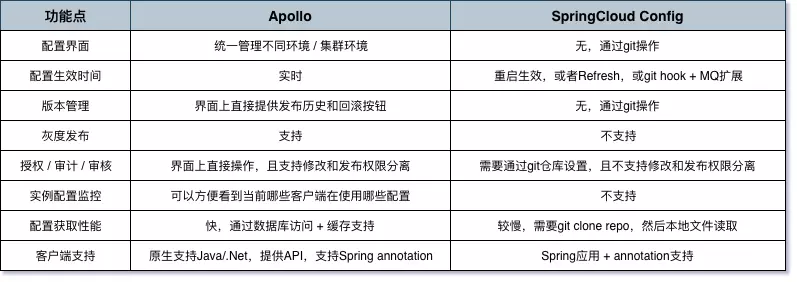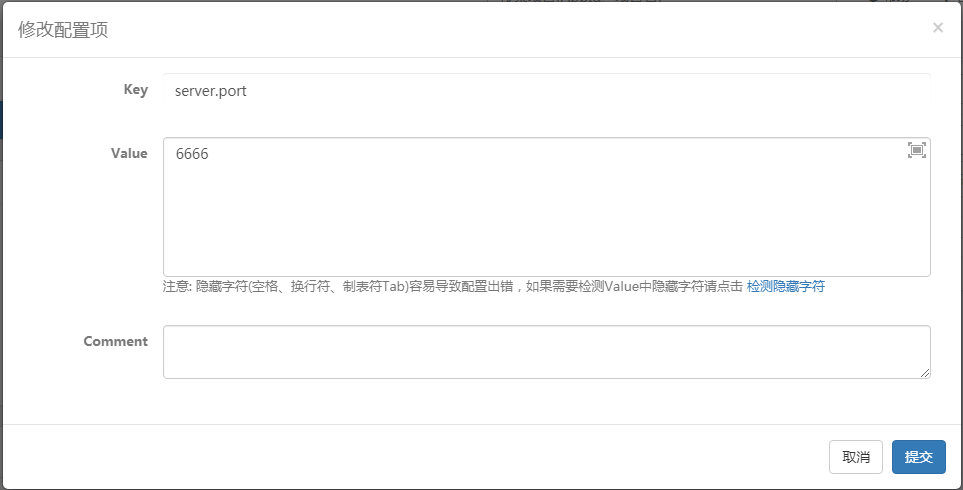整合apollo
Apollo(阿波罗)是携程框架部门研发的分布式配置中心,能够集中化管理应用不同环境、不同集群的配置,配置修改后能够实时推送到应用端,并且具备规范的权限、流程治理等特性,适用于微服务配置管理场景。
Apollo和Spring Cloud Config对比

搭建教程
https://github.com/ctripcorp/apollo/wiki/Quick-Start
pom依赖
<dependency>
<groupId>com.ctrip.framework.apollo</groupId>
<artifactId>apollo-client</artifactId>
<version>1.3.0</version>
</dependency>
<!-- 为了编码方便,并非apollo 必须的依赖 -->
<dependency>
<groupId>org.apache.commons</groupId>
<artifactId>commons-lang3</artifactId>
<version>3.8.1</version>
</dependency>
application.yml
server: port: 6001 app: id: boot-apollo apollo: meta: http://localhost:8080/ //server 地址 bootstrap: enabled: true eagerLoad: enabled: true
- app.id:AppId是应用的身份信息,是配置中心获取配置的一个重要信息。
- apollo.bootstrap.enabled:在应用启动阶段,向Spring容器注入被托管的application.properties文件的配置信息。
- apollo.bootstrap.eagerLoad.enabled:将Apollo配置加载提到初始化日志系统之前。
HelloController
package com.smart.controller; import lombok.extern.slf4j.Slf4j; import org.springframework.beans.factory.annotation.Value; import org.springframework.web.bind.annotation.GetMapping; import org.springframework.web.bind.annotation.RequestMapping; import org.springframework.web.bind.annotation.RestController; @Slf4j @RestController @RequestMapping("/hello") public class HelloController { @Value("${server.port}") private int serverPort; @GetMapping("apollo") public String helloApollo(){ log.debug("-----------this is just a test-----------------"); return "hi Apollo "+serverPort; } }
启动类
@SpringBootApplication @EnableApolloConfig public class BootApolloApplication { public static void main(String[] args) { SpringApplication.run(BootApolloApplication.class, args); } }
配置中心配置
创建项目

填写配置信息
- 部门:选择应用所在的部门。
- 应用AppId:用来标识应用身份的唯一id,格式为string,需要和客户端。application.properties中配置的app.id对应。
- 应用名称:应用名,仅用于界面展示。
- 应用负责人:选择的人默认会成为该项目的管理员,具备项目权限管理、集群创建、Namespace创建等权限。

发布配置
配置只有在发布后才会真的被应用使用到,所以在编辑完配置后,需要发布配置。点击“发布按钮”。
注意:
- 服务的端口依然还是 6001,这是因为 apollo 修改配置,不会像Spring Cloud Config 那样去重启应用。
- 重启应用后,客户端会加载使用 配置中心中配置的属性的值,例如我们重启我们的应用,服务端口会变成6666。
一般在开发环境下使用DEBUG级别的日志输出,为了方便查看问题,而在线上一般都使用INFO或者ERROR级别的日志,主要记录业务操作或者错误的日志。把日志的配置部署到Apollo配置中心,但在配置中心修改日志等级,依然需要重启应用才生效,下面我们就通过监听配置的变化,来达到热更新的效果。
package com.smart.config; import com.ctrip.framework.apollo.Config; import com.ctrip.framework.apollo.model.ConfigChangeEvent; import com.ctrip.framework.apollo.spring.annotation.ApolloConfig; import com.ctrip.framework.apollo.spring.annotation.ApolloConfigChangeListener; import lombok.extern.slf4j.Slf4j; import org.apache.commons.lang3.StringUtils; import org.springframework.beans.factory.annotation.Autowired; import org.springframework.boot.logging.LogLevel; import org.springframework.boot.logging.LoggingSystem; import org.springframework.context.annotation.Configuration; import javax.annotation.PostConstruct; import java.util.Set; @Slf4j @Configuration public class LoggerConfig { private static final String LOGGER_TAG = "logging.level."; @Autowired private LoggingSystem loggingSystem; @ApolloConfig private Config config; @ApolloConfigChangeListener private void configChangeListener(ConfigChangeEvent changeEvent) { refreshLoggingLevels(); } @PostConstruct private void refreshLoggingLevels() { Set<String> propertyNames = config.getPropertyNames(); for (String key : propertyNames) { if (StringUtils.contains(key, LOGGER_TAG)) { String strLevel = config.getProperty(key, "info"); LogLevel logLevel = LogLevel.valueOf(strLevel.toUpperCase()); loggingSystem.setLogLevel(key.replace(LOGGER_TAG, ""), logLevel); log.info("{}:{}",key,logLevel); } } } }
- @ApolloConfig注解: 将Apollo服务端的中的配置注入这个类中。
- @ApolloConfigChangeListener注解:监听配置中心配置的更新事件,若该事件发生,则调用refreshLoggingLevels方法,处理该事件。
- ConfigChangeEvent参数:可以获取被修改配置项的key集合,以及被修改配置项的新值、旧值和修改类型等信息。
立志如山 静心求实






 浙公网安备 33010602011771号
浙公网安备 33010602011771号